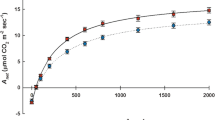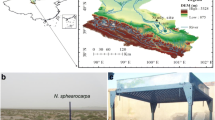Abstract
South-eastern Utah forms a northern border for the region currently influenced by the Arizona monosoonal system, which feeds moisture and summer precipitation into western North America. One major consequence predicted by global climate change scenarios is an intensification of monosoonal (summer) precipitation in the aridland areas of the western United States. We examined the capacity of dominant perennial shrubs in a Colorado Plateau cold desert ecosystem of southern Utah, United States, to use summer moisture inputs. We simulated increases of 25 and 50 mm summer rain events on Atriplex canescens, Artemisia filifolia, Chrysothamnus nauseosus, Coleogyne ramosissima, and Vanclevea stylosa, in July and September with an isotopically enriched water (enriched in deuterium but not 18O). The uptake of this artificial water source was estimated by analyzing hydrogen and oxygen isotope ratios of stem water. The predawn and midday xylem water potentials and foliar carbon isotope discrimination were measured to estimate changes in water status and water-use efficiency. At. canescens and Ch. nauseosus showed little if any uptake of summer rains in either July or September. The predawn and midday xylem water potentials for control and treatment plants of these two species were not significantly different from each other. For A. filifolia and V. stylosa, up to 50% of xylem water was from the simulated summer rain, but the predawn and midday xylem water potentials were not significantly affected by the additional summer moisture input. In contrast, C. ramosissima showed significant uptake of the simulated summer rain (>50% of xylem water was from the artificial summer rain) and an increase in both predawn and midday water potentials. The percent uptake of simulated summer rain was greater when those rains were applied in September than in July, implying that high soil temperature in midsummer may in some way inhibit water uptake. Foliar carbon isotope discrimination increased significantly in the three shrubs taking up simulated summer rain, but pre-treatment differences in the absolute discrimination values were maintained among species. The ecological implications of our results are discussed in terms of the dynamics of this desert community in response to changes in the frequency and dependability of summer rains that might be associated with a northward shift in the Arizona monsoon boundary.
Similar content being viewed by others
References
Adang TC, Gall RL (1989) Structure and dynamics of the Arizona Monsoon boundary. Mon Weath Rev 117: 1423–1438
Barnes CJ, Allison GB (1983) The distribution of deuterium and 18O in dry soils. J Hydrol 60: 141–156
Benson L, Klieforth H (1989) Stable isotopes in precipitation and ground water in the Yucca Mountain region, southern Nevada: paleoclimatic implications. In: Peterson DH (ed) Aspects of climate variability in the Pacific and the western Americas. American Geophysical Union, Washington, pp 41–59
Betancourt JL, Van Devender TR, Martin PS (1990) Packrat middens: the last 40000 years of biotic change. University of Arizona Press, Tucson
Bowns JE, West NE (1976) Blackbrush (Coleogyne ramosissima Torr.) on southwestern Utah range lands (research report 27). Utah Agricultural Experiment Station, Logan
Bryson RA, Lowry RP (1955) Synoptic climatology of the Arizona summer precipitation singularity. Bull Am Meteorol 36: 329–339
Caldwell MM (1985) Cold deserts. In: Chabot BF, Mooney HA (eds) Physiological ecology of North American plant communities. Chapman and Hall, New York, pp 198–212
Caldwell MM, Richards JH (1986) Competing root systems: morphology and models of absorption. In: Givnish TJ (ed) On the economy of plant form and function. Cambridge University Press, Cambridge, pp 251–273
Caldwell MM, Richards JH (1989) Hydraulic lift: water efflux from upper roots improves effectiveness of water uptake by deep roots. Oecologia 79: 1–5
Cole K (1990) Late Quaternary zonation of vegetation in the eastern Grand Canyon. Science 217: 1142–1145
Coleman ML, Shepard TJ, Durham JJ, Rouse JE, Moore GR (1982) Reduction of water with zinc for hydrogen isotope analysis. Anal Chem 54: 993–995
Comstock JP, Ehleringer JR (1992) Plant adaptation in the Great Basin and Colorado Plateau. Great Basin Nat 52: 195–215
Craig H, Gordon LI, Horibe Y (1963) Isotopic exchange effects in the evaporation of water. J Geophys Res 68: 5079–5087
Dawson TE (1993) Water sources of plants as determined from xylem-water isotopic composition: perspectives on plant competition, distribution, and water relations. In: Ehleringer JR, Hall AE, Farouhar (eds) Stable isotopes and plant carbon-water relations. Academic Press, San Diego, pp 465–496
Dobrowolski JP, Caldwell MM, Richards JH (1990) Basin hydrology and plant root systems. In: Osmond CB, Pitelka LF, Hidy GM (eds) Plant biology of the basin and range. Springer, Berlin Heidelberg New York, pp 243–292
Donovan LA, Ehleringer JR (1992) Contrasting water-use patterns among size life-history classes of a semi-arid shrub. Funct Ecol 6: 482–488
Donovan LA, Ehleringer JR (1994) Water stress and use of summer precipitation in a Great Basin shrub community. Funct Ecol 8: 289–297
Ehleringer JR (1993a) Gas exchange implications of isotopic variation in aridland plants. In: Smith JAC, Griffiths H (eds) Water deficits: plant responses from cell to community. BIOS, London, pp 265–284
Ehleringer JR (1993b) Carbon and water relations in desert plants: an isotopic perspective. In: Ehleringer JR, Hall AE, Farquhar GD (eds) Stable isotopes and plant carbon/water relations. Academic Press, San Diego, pp 155–172
Ehleringer JR, Dawson TE (1992) Water uptake by plants: perspectives from stable isotope composition. Plant Cell Environ 15: 1073–1082
Ehleringer JR, Mooney HA (1983) Productivity of desert and mediterranean-climate plants. In: Lange OL, Nobel PS, Osmond CB, Ziegler H (eds) Physiological plant ecology IV (Encyclopedia of Plant Physiology, NS, vol 12D). Springer, Berlin Heidelberg New York, pp 205–231
Ehleringer JR, Osmond CB (1989) Stable isotopes. In: Pearcy RW, Ehleringer JR, Mooney HA, Rundel PW (eds) Plant physiological ecology, field methods and instrumentation. Chapman and Hall, New York, pp 281–300
Ehleringer JR, Phillips SL, Schuster WSF, Sandquist DR (1991) Differential utilization of summer rains by desert plants. Oecologia 88: 430–434
Epstein S, Mayeda T (1953) Variations of the 18O content of water from natural sources. Geochim Cosmochim Acta 42: 213–224
Evanari M, Noy-Meir I, Goodall DW (1986) Hot deserts and arid shrublands. Elsevier, Amsterdam
Evans RD, Ehleringer JR (1994) Water and nitrogen dynamics in an arid woodland. Oecologia 99: 233–242
Everett RL, Tueller PT, Davis JB, Brunner AD (1980) Plant phenology in galleta-shadescale and galleta-sagebrush associations. J Range Manage 33: 446–450
Farquhar GD, Ehleringer JR, Hubick KT (1989) Carbon isotope discrimination and photosynthesis. Annu Rev Plant Physiol Mol Biol 40: 503–537
Fernandez OA, Caldwell MM (1975) Phenology and dynamics of root growth of three cool semi-desert shrubs under field conditions. J Ecol 63: 703–714
Flanagan LB, Ehleringer JR, Marshall JD (1992) Differential uptake of summer precipitation among cooccurring trees and shrubs in a pinyon-juniper woodland. Plant Cell Environ 15: 831–836
Fowler N (1986) The role of competition in plant communities in arid and semi-arid regions. Annu Rev Ecol Syst 17: 89–110
Friedman I, Smith GI, Gleason JD, Warden A, Harris JM (1992) Stable isotope composition of waters in southeastern California. 1. Modern precipitation. J Geophys Res 97: 5795–5812
Gregg J (1991) The differential occurrence of the mistletoe, Phoradendron juniperinum, on its host, Juniperus osteosperma, in the Western United States. MS Thesis, University of Utah, Salt Lake City
Hadley NF, Szarek SR (1981) Productivity of desert ecosystems. BioScience 31: 747–753
Harte J, Shaw R (1995) Shifting dominance within a montane vegetation community: results of a climate-warming experiment. Science 267: 876–880
Hendrick RL, Pregitzer KS (1993) Patterns of fine root mortality in two sugar maple forests. Nature 361: 59–61
Houghton JG (1979) A model for orographic precipitation in the north central Great Basin. Mon Weath Rev 107: 1462–1475
Ingraham NL, Lyles BF, Jacobson RL, Hess JW (1991) Stable isotopic study of precipitation and spring discharge in southern Nevada. J Hydrol 125: 243–258
Mitchell JBF, Manabe S, Meleshko V, Tokioka T (1990) Equilibrium climate change and its implications for the future. In: Houghton JT, Jenkins GJ, Ephraums JJ (eds) Climate change: the IPCC scientific assessment. Cambridge University Press, Cambridge
Mitchell VL (1976) The regionalization of climate in the western United States. J Appl Meteorol 15: 920–977
Moore TJ, Gall RL, Adang TC (1989) Disturbances along the Arizona Monsoon boundary. Mon Weath Rev 117: 932–941
Phillips SL, Ehleringer JR (1995) Limited uptake of summer precipitation by bigtooth maple (Acer grandidentatum Nutt) and Gambel's oak (Quercus gambelii Nutt). Trees 9: 214–219
Rind D, Goldenberg R, Hansen J, Rosenzweig C, Ruedy R (1990) Potential evapotranspiration and the likelihood of future drought. J Geophys Res 95: 9983–10004
Sala OE, Golluscio RA, Lauenroth WK, Soriano A (1989) Resource partitioning between shrubs and grasses in the Patagonian steppe. Oecologia 81: 501–505
Schlesinger ME, Mitchell JBF (1987) Climate model simulations of the equilibrium climatic response to increased carbon dioxide. Rev Geophys 25: 760–798
Smith SD, Nowak RS (1990) Ecophysiology of plants in the inter-mountain lowlands. In: Osmond CB, Pitelka LF, Hidy GM (eds) Plant biology of the basin and range (Ecological studies vol 80). Springer, Berlin Heidelberg New York, pp 179–241
Socki RA, Karisson HR, Gibson EK Jr (1992) Extraction technique for the determination of oxygen-18 in water using pre-evacuated glass vials. Anal Chem 64: 829–830
Stine S (1994) Extreme and persistent drought in California and Patagonia during medieval time. Nature 369: 546–549
Tang M, Reiter ER (1984) Plateau monsoons of the northern hemisphere: a comparison between North America and Tibet. Mon Weath Rev 112: 617–637
Taylor K, Rose M (1992) Relationship of solar activity and climatic oscillations on the Colorado Plateau. J Geophys Res 97: 15803–15811
Turner FB, Randal DC (1987) The phenology of desert shrubs in southern Nevada. J Arid Environ 13: 119–128
Van Devender TR, Spaulding WG (1979) Development of vegetation and climate in the southwestern United States. Science 204: 701–710
Van Devender TR, Thompson RS, Betancourt JL (1987) Vegetation history of the deserts of southwestern North America; the nature and timing of the late Wisconsin-Holocene transition. In: Ruddiman WF, Wright HE Jr (eds), North America and adjacent oceans during the last deglaciation. Geological Society of America, Boulder, pp 323–352
Zimmermann U, Ehalt D, Munnich KO (1967) Soil-water movement and evapotranspiration: Changes in the isotopic composition of the water. Proceedings of the IAEA Symposium on Isotopes in Hydrology, Vienna, pp 567–585
Author information
Authors and Affiliations
Corresponding author
Rights and permissions
About this article
Cite this article
Lin, G., Phillips, S.L. & Ehleringer, J.R. Monosoonal precipitation responses of shrubs in a cold desert community on the Colorado Plateau. Oecologia 106, 8–17 (1996). https://doi.org/10.1007/BF00334402
Received:
Accepted:
Issue Date:
DOI: https://doi.org/10.1007/BF00334402




